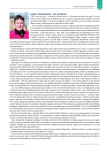Comments on the Glagov study
Authors:
Tomáš Kovárník; Jan Pudil; Kristýna Bayerová
Authors‘ workplace:
II. interní klinika kardiologie a angiologie 1. LF UK a VFN v Praze
Published in:
AtheroRev 2017; 2(2): 93-97
Category:
clinical studies
Overview
The GLAGOV study has asked the question whether the dramatic decreases in LDL-cholesterol levels, as demonstrated by the previous studies on evolocumab, will also lead to the decrease in volumes of coronary atherosclerotic plaques. Patients with both stable and acute forms of ischemic heart disease (unstable angina and non-ST-segment-elevation myocardial infarction) were included in the study. Coronary plaques were assessed with intravascular ultrasound and, in part of the patients, also through virtual histology in order to assess the composition of atherosclerotic plaques. There were 970 patients randomized in the study, who were treated with a stable statin dose, randomized in the ratio of 1 : 1 for the treatment with evolocumab in the subcutaneous dose of 420 mg once a month, or for placebo application for a period of 78 weeks. The primary goal was the absolute change in the relative plaque volume (percent atheroma volume – PAV). In the branch treated with evolocumab the PAV was reduced by 0.95 %, whereas in the placebo branch the PAV progressed by 0.05 %. This difference was statistically highly significant (CI 95% -1.8 to -0.64 %; p < 0.001). The secondary goal was to reach a difference in the total atheroma volume – TAVnorm. In the patients treated with evolocumab in combination with statins the TAV decreased by 5.8 mm3, whereas in the group treated only by statins it progressed by 0.9 mm3. This difference was again statistically highly significant (CI 95% -7.3 to -2.5 mm3; p < 0.001). The study has shown a statistically significant decrease in the volume of atherosclerotic plaques in the patients who had evolocumab added to their statin therapy. The study was not intended to monitor clinical consequences of these morphological changes which have been proven in the recently published FOURIER study.
Key words:
evolocumab, intravascular ultrasound, coronary atherosclerosis
Sources
1. Nicholls S, Puri R, Anderson T et al. Effect of Evolocumab on Progression of Coronary Disease in Statin-Treated Patients: The GLAGOV Randomized Clinical Trial. JAMA 2016; 316(22): 2373–2384. Dostupné z DOI: <http://dx.doi.org/10.1001/jama.2016.16951>.
2. Stroes E, Guyton JR, Lepor N et al. [ODYSSEY CHOICE II Investigators]. Efficacy and Safety of Alirocumab 150 mg Every 4 Weeks in Patients With Hypercholesterolemia Not on Statin Therapy: The ODYSSEY CHOICE II Study. J Am Heart Assoc 2016; 5(9). pii: e003421. Dostupné z DOI: <http://dx.doi.org/10.1161/JAHA.116.003421>.
3. Koren M, Giugliano R, Raal F et al. Efficacy and Safety of Longer-Term Administration of Evolocumab (AMG 145) in Patients With Hypercholesterolemia 52-Week Results From the Open-Label Study of Long-Term Evaluation Against LDL-C (OSLER) Randomized Trial. Circulation 2014; 129(2): 234–243. Dostupné z DOI: <http://dx.doi.org/10.1161/CIRCULATIONAHA.113.007012>.
4. Tsujita K, Sugiyama S, Sumida H et al. [PRECISE–IVUS Investigators]. Impact of Dual Lipid-Lowering Strategy With Ezetimibe and Atorvastatin on Coronary Plaque Regression in Patients With Percutaneous Coronary Intervention: The Multicenter Randomized Controlled PRECISE-IVUS Trial. JACC 2015; 66(5): 495–507. Dostupné z DOI: <http://dx.doi.org/10.1016/j.jacc.2015.05.065>.
5. Park SJ, Kang SJ, Ahn JM et al. Visual-Functional Mismatch between Coronary Angiography and Fractional Flow Reserve. JACC CV Interventions 2012; 5(10): 1029–1036. Dostupné z DOI: <http://dx.doi.org/10.1016/j.jcin.2012.07.007>.
6. Kern MJ, Lerman A, Bech JW et al. Physiological assessment of coronary artery disease in the cardiac catheterization laboratory: a scientific statement from the American Heart Association Committee on Diagnostic and Interventional Cardiac Catheterization, Council on Clinical Cardiology. Cirulation 2006; 114(12): 1321–1341.
7. Gould KL, Kelley KO. Physiological Significance of Coronary Flow Velocity and Changing Stenosis Geometry during Coronary Vasodilation in Awake Dogs. Circ Res 1982; 50(5): 695–704.
8. Hiro T, Kimura T, Morimoto T et al. Effect of intensive statin therapy on regression of coronary atherosclerosis in patients with acute coronary syndrome: a multicenter randomized trial evaluated by volumetric intravascular ultrasound using pitavastatin versus atorvastatin (JAPAN-ACS [Japan assessment of pitavastatin and atorvastatin in acute coronary syndrome] study). JACC 2009; 54(4): 293–302. Dostupné z DOI: <http://dx.doi.org/10.1016/j.jacc.2009.04.033>.
9. Tsujita K, Sugiyama S, Sumida H et al. Impact of dual lipid-lowering strategy with ezetimibe and atorvastatin on coronary plaque regression in patients with percutaneous coronary intervention. The multicenter randomized controlled PRECISE-IVUS Trial. JACC 2015; 66(5): 495–507. Dostupné z DOI: <http://dx.doi.org/10.1016/j.jacc.2015.05.065>.
10. Nicholls SJ, Hsu A, Wolski K et al. Intravascular ultrasound-derived measures of coronary atherosclerotic plaque burden and clinical outcome. JACC 2010; 55(21): 2399–2407. Dostupné z DOI: <http://dx.doi.org/10.1016/j.jacc.2010.02.026>.
11. Kovarnik T, Chen Z, Wahle A et al. Pathologic Intimal Thickening Plaque Phenotype – not as innocent as we thought. A Serial 3D intravascular ultrasound – Virtual Histology Study. Rev Esp Cardiol (Engl Ed) 2017; 70(1): 25–33. Dostupné z DOI: <http://dx.doi.org/10.1016/j.rec.2016.04.058>.
12. Missel E, Mintz GS, Carlier S et al. Necrotic Core and Its Ratio to Dense Calcium Are Predictors of High-Risk Non–ST-Elevation Acute Coronary Syndrome. Am J Cardiol 2008; 101(5): 573–575. Dostupné z DOI: <http://dx.doi.org/10.1016/j.amjcard.2007.10.018>.
13. Hou J, Xing L, Jia H et al. Comparison of Intensive Versus Moderate Lipid-Lowering Therapy on Fibrous Cap and Atheroma Volume of Coronary Lipid-Rich Plaque Using Serial Optical Coherence Tomography and Intravascular Ultrasound Imaging. Am J Cardiol 2016; 117(5): 800–806. Dostupné z DOI: <http://dx.doi.org/10.1016/j.amjcard.2015.11.062>.
14. Sabatine M, Giugliano R, Keech A et al. Evolocumab and Clinical Outcomes in Patients with Cardiovascular Disease. N Engl J Med 2017; 376(18): 1713–1722. Dostupné z DOI: <http://dx.doi.org/10.1056/NEJMoa1615664>.
Labels
Angiology Diabetology Internal medicine Cardiology General practitioner for adultsArticle was published in
Athero Review

2017 Issue 2
Most read in this issue
- What is the role of nutriceuticals in dyslipidemia management? Armolipid Plus
- Combination treatment with antihypertensive and hypolipidemic drugs
-
Remnant cholesterol: a fact or fiction?
Reflection on the problems related to remnant cholesterol - Changes in the lipid spectrum in endocrinopathies
